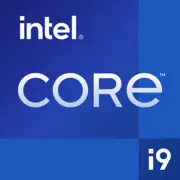Intel Core i9-12900HK

Intel Core i9-12900HK: The Power of Alder Lake in a Mobile Format
(March 2025)
In the world of mobile processors, the Intel Core i9-12900HK remains a notable player even several years after its release. This chip, built on the hybrid Alder Lake architecture, combines high performance and adaptability, making it relevant for top-tier laptops in 2025. Let’s explore who should consider this processor, its strengths, and what to pay attention to when choosing a device.
1. Architecture and Technology: A Hybrid Approach and New Technologies
Hybrid Core Structure
The Core i9-12900HK is one of Intel's first mobile processors with a hybrid architecture. It features:
- 6 Performance cores (P-cores) with Hyper-Threading support (12 threads) and a maximum turbo frequency of 5.0 GHz. These cores are optimized for resource-intensive tasks: rendering, gaming, and 3D modeling.
- 8 Efficient cores (E-cores) without Hyper-Threading, operating at frequencies up to 3.8 GHz. They handle background processes and energy efficiency.
In total: 14 cores and 20 threads, providing flexible workload distribution. For instance, while working in Photoshop, P-cores process filters, while E-cores manage interface updates and background applications.
Intel 7 Process Technology
Despite its marketing name, the process technology corresponds to the 10nm standard (Enhanced SuperFin). This has allowed for reduced power consumption compared to previous generations (e.g., Tiger Lake), while maintaining high frequencies.
Integrated Iris Xe Graphics
The Iris Xe iGPU (96 EU) supports:
- 4K displays at 120 Hz;
- AV1 decoding and HEVC encoding;
- Connection of up to four external monitors.
For less demanding games (CS:GO, Dota 2) at medium settings, it delivers 50-60 FPS. However, in 2025, a discrete graphics card (e.g., RTX 4070 or above) will be required for AAA titles.
2. TDP and Power Consumption: Balancing Power and Portability
The nominal TDP of the processor is 45 W, but in turbo mode, consumption can reach 115 W. This creates two scenarios:
- In ultrabooks with passive cooling, the chip is limited to 35-45 W, reducing performance.
- In gaming laptops with powerful coolers (e.g., ASUS ROG Zephyrus or MSI Raider), the processor unleashes its potential but increases heat and noise.
Tip: When buying, check the cooling system. For example, laptops with vapor chambers and three fans (like the Razer Blade 16) handle peak loads better.
3. Performance: Real-World Tasks and Turbo Mode
Office Work and Multitasking
- Running 30+ tabs in Chrome + streaming video + working in Excel — the load is distributed to E-cores, maintaining a smooth interface.
- Rendering 4K video in Premiere Pro: a 10-minute clip is processed in 6-8 minutes thanks to P-cores.
Gaming
- Paired with an RTX 4070 (Lenovo Legion Pro 7i) in Cyberpunk 2077 (Ultra, DLSS Quality) — 75-90 FPS. The processor does not become a bottleneck.
- In turbo mode, P-core frequencies stay at 4.8-5.0 GHz for up to 10-15 minutes, after which they drop to 4.2-4.5 GHz due to overheating.
Multimedia
- Video conversion in HandBrake (H.265): 20% faster than the i7-12700H.
- Geekbench 6 test: 2186 (Single-Core), 10115 (Multi-Core) — results close to the desktop Ryzen 7 5800X.
4. Use Cases: Who Needs the i9-12900HK?
- Professionals: Video editors, engineers (AutoCAD, SolidWorks), developers.
- Gamers: For 2K/4K gaming with discrete graphics.
- Enthusiasts: Anyone who values “headroom” for future tasks.
Not Recommended:
- For basic tasks (web browsing, office work) — it’s overkill. Better to choose an i5 or Ryzen 5.
- For ultraportable devices — high heat output reduces battery life.
5. Battery Life: How Long Will the Battery Last?
- Under load (gaming, rendering): 1.5-2.5 hours.
- In power-saving mode (office tasks, 50% brightness): 5-7 hours.
Power Saving Technologies:
- Intel Dynamic Tuning 3.0: Automatically switches cores to minimize consumption.
- Adaptix™ Technology: Optimizes voltage and frequency in real-time.
Tip: In Windows settings, select the “Power Saver” mode to increase battery life by 20-30%.
6. Comparison with Competitors
- AMD Ryzen 9 7940HS (Zen 4): Better in multi-threaded tasks (Blender, Cinebench) by 10-15%, but weaker in single-threaded (gaming, Adobe).
- Apple M3 Max: 30% more energy efficient, but limited compatibility with Windows programs.
- Intel Core i9-13900HK: The new generation offers a performance boost of 8-12%, but laptops with it are $300-500 more expensive.
7. Pros and Cons
Strengths:
- Record-breaking single-core performance.
- Supports DDR5-4800 and PCIe 5.0 (relevant for SSDs and external GPUs).
- Versatility: suitable for both work and gaming.
Weaknesses:
- High heat output under load.
- Battery life lower than Ryzen 9 or Apple Silicon.
- Price: laptops with this processor range from $1800 (basic models) to $3000 (high-end configurations).
8. Recommendations for Laptop Selection
- Gaming Models: ASUS ROG Strix Scar 16, MSI Titan GT77 — emphasis on cooling and discrete graphics.
- Workstations: Dell XPS 17, HP ZBook Fury — high-quality screens and ports (Thunderbolt 4, HDMI 2.1).
- Ultrabooks: Not recommended due to thermal limitations.
What to Look For:
- At least 32 GB of DDR5.
- 1 TB or larger SSD PCIe 4.0/5.0.
- Display with a refresh rate of 120 Hz and 100% sRGB coverage.
9. Final Conclusion
The Intel Core i9-12900HK in 2025 remains a choice for those seeking a mobile PC “without compromises.” It is ideal for:
- Professionals working with “heavy” applications.
- Gamers wanting to play in 4K.
- Users who appreciate an upgrade to DDR5 and PCIe 5.0.
Alternatives:
- If battery life is important — consider the Apple M3.
- If budget is limited — the AMD Ryzen 9 7940HS offers better price-to-performance in multi-threaded tasks.
Overall, the i9-12900HK is an investment in performance that will pay off over 3-4 years of active use.
Basic
CPU Specifications
Memory Specifications
GPU Specifications
Miscellaneous
Benchmarks
Compared to Other CPU
Share in social media
Or Link To Us
<a href="https://cputronic.com/en/cpu/intel-core-i9-12900hk" target="_blank">Intel Core i9-12900HK</a>